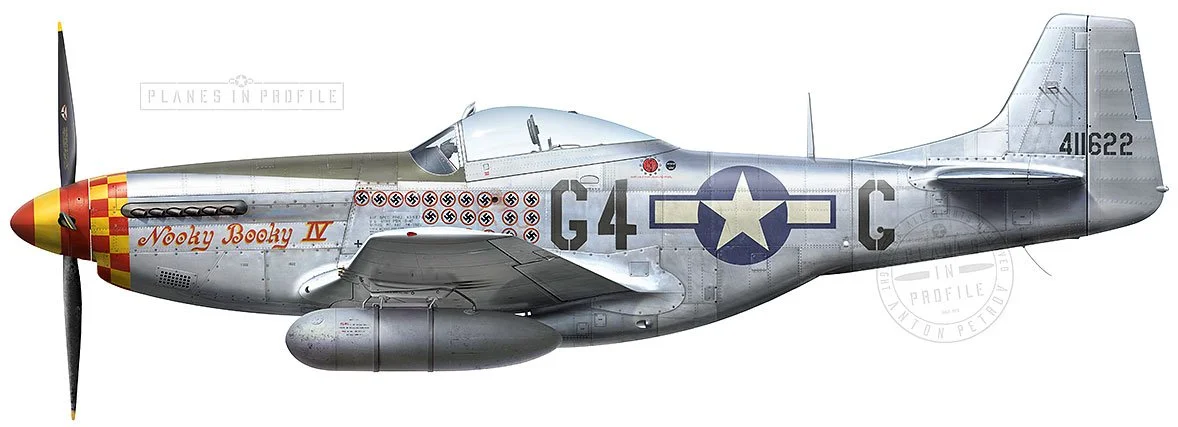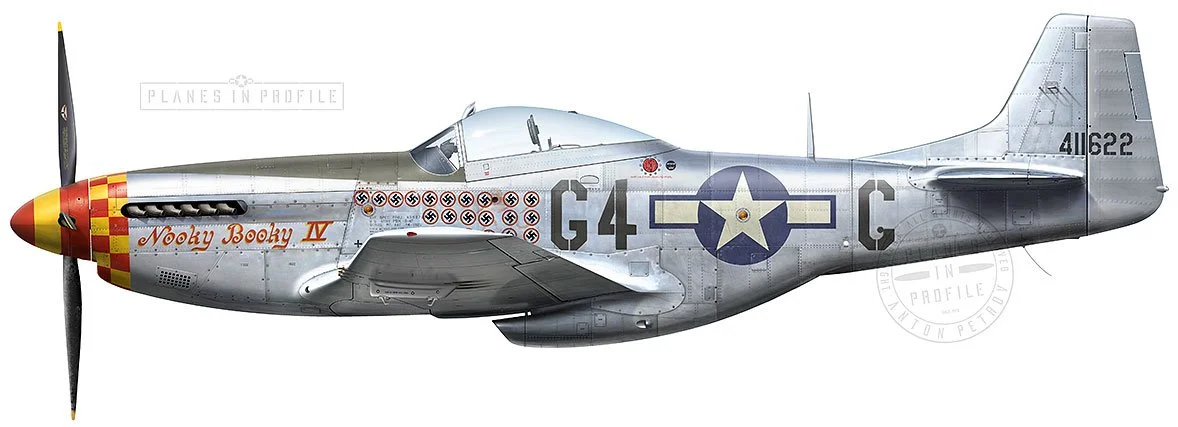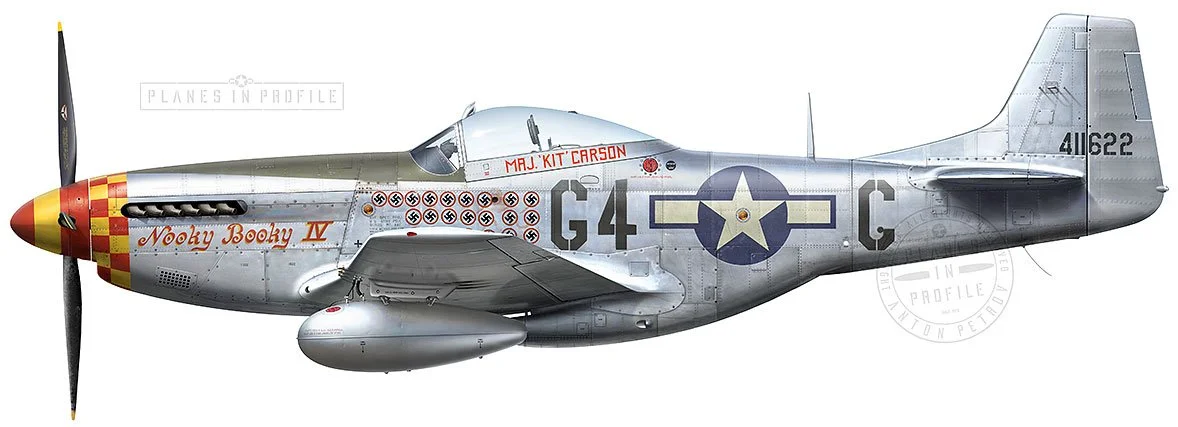Carson’s “Nooky Booky IV”
North American, P-51K-5-NT (Mustang), Serial number 44-11622
362nd Fighter Squadron, 357th Fighter Group, 8th Air Force, Leiston, England, Dec 1944 - end of the war.
Flown by Maj. Leonard Kyle ‘Kit’ Carson.
44-11622 as it looked in mid December 1944, before Carson scored the first aerial victory in this airplane. The image is based on this photo http://aaron.smith.free.fr/PilotsPlanes/Carson.JPG . It’s worth noting the following features:
1) There were 18 victory markings painted on the airplane at this time (each represented by a black swastika inside a red circle ), these were displayed in three rows of six. They were presumably Carson’s 14.5 aerial victories plus 3.5 strafing kills, all scored while flying his previous airplanes.
2) The presence of the D-Day stripes. What is quite interesting about these is that the black/white pattern is inverted which is quite unique - the white stripes appear in place of the black stripes and vice versa.
There were probably no recognition stripes painted on the wings and horizontal stabilisers.
3) Although this plane was made at the Dallas plant it seems to be fitted with an Englewood plant’s canopy hood. The second version of the Englewood hood to be specific, judging by its overall shape and the short lock latch on the port side.
4) ‘Aeroproducts’ propeller.
5) AN/APS-13 Radio set antena array on the vertical fin.
‘Nooky-Booky IV’ was the forth and the last P-51 assigned to Major Leonard "Kit" Carson. The name ‘Nooky Booky’ was originally given to Carson’s first P-51 (a P-51B) by his crew chief and Carson continued to use the name for his next 3 Mustangs. By the time he began flying this warbird he had already raked up 14.5 aerial kills, including 5 kills on the Nov 27th, 1944, which made him only the second, and last, 357FG pilot to to make ‘ace in one day’. While flying Nooky Booky IV in late 1944 and in 1945 Carson added another 4 aerial kills, plus 2 damaged (plus 1 damaged while flying a different P-51) to his tally.
The first victory in Nooky Booky IV came on Christmas Eve 1944. On that day the ace came across a gaggle of fifty to sixty FW-190s passing below the Mustangs in the vicinity of Fulda, Germany. The Mustangs swooped down on the enemy and the gaggle went into a Lufbery circle as the air battle began. Carson saw one of the P-51s being attacked, so he tacked onto the attacking FW-190. Though the enemy tried evasive manoeuvres it couldn’t escape Nooky Booky IV’s gun fire. The enemy was hit several times, went into a split-S manoeuvre and didn’t pull out. [1]
Dec 24, 1944, 1 x FW-190 Vicinity of Fulda, Germany.
The next victories came on Jan14th, 1945, when 357th FG got into its biggest air battle of the war and destroyed a total of fifty-six enemy aircraft! - a battle that was henceforth referred to by the 357th as “The Big One”. Carson, while flying Nooky Booky IV, claimed three of these.
On that day 357th was tasked with providing cover for bombers attacking the German town of Derben. While escorting the bombers they were met by a large number of enemy fighters. The first gaggle of FW-190s attacked the allied bomber formation head-on. Carson’s Blue flight tore into the gaggle, breaking the enemy formation on the first pass. Carson went after part of the formation, attacking its tail end. In Carson’s words:
‘…I closed to about 400 yards on an Fw-190 at the rear on the outside and fired a good burst that hit home all over his fuselage. he took no evasive action, but just peeled down to the right very slowly. I followed him down. His turns became more violent and then he started snapping from the right to the left. he was smoking quite badly. I believe the pilot was killed. I pulled off and watched him until he hit the dirt'. [2]
When Carson’s flight went back up to the bombers they have noticed another gaggle of 40 to 50 FW-190s approaching the bombers from “six o’clock”. The Mustangs attacked the enemy head-on. After the first pass which produced no strikes, the Mustangs turned around and got themselves onto the enemy’s tails. Carson picked a Fw-190 which still had its drop tanks attached and fired at it. In Carson’s words:
‘After we got behind them, I fired a burst from 350-400 yards at an Fw-190, getting strikes. He did a couple of snaps to the right and wound up on his back. I fired again, getting more hits on the fuselage. Pieces came off the enemy ship and he began smoking. He split-ess’ed and headed for the deck. I followed him down until he hit, bounced and crashed.’ [2]
After pulling back up Carson noticed two Me-109s below. As Carson attacked them, unsuccessfully, they went into a Lufbery circle. Carson pulled up and then followed with another ill-timed pass after which he pulled up again. At this time the Fw-190 leader broke off and wend for the deck. So Carson went down on the tail of the second 109 which at that time pulled up and was loosing speed. Carson pressed the trigger:
’I fired at about 300 yards, closing down to about 20 yards, and scored hits all over the fuselage. His coolant blew as I pulled up over him. Then he went into a sort of tumbling spiral and crashed.’ [2]
Jan 14, 1945 2 x FW-190 20 miles NW of Berlin, Germany
1 x Me-109 20 miles NW of Berlin, Germany
Nooky Booky IV as it appeared in early 1945. The image is based on this photo https://www.iwm.org.uk/collections/item/object/205372421 . Note the following:
1) Four new victory markings were added to the front of the top row of victories .The top row went from 6 to 10 victories, while the two bottom rows of 6 victories each were unchanged. The plane now displayed a total of 22 victories.
1) The absence of the D-Day stripes,
The later version of Nooky Booky IV as it appeared in early 1945. The image is based on this photo http://www.littlefriends.co.uk/wp-content/groupimages/gallery/357g/g4-c3.jpg . Note the following:
2) The exhaust shrouds were removed.
3) ‘Formation lights’ were installed. One in the centre of the star insignia and one just above the data block.
On March 31st, Maj. L.Carson had an encounter with an Me-262 in which he damaged it and prevented it from attacking an air-sea rescue attempt north of Just Island, however he was not flying Nooky Booky IV on that occasion. Nooky Booky IV’s next and last victims were two damaged Me-162 jets. These happened on April 18th, while attacking a jet base near Prague, Czechoslovakia.
April 18, 2 x Me-262 (damaged) Prague-Ruzne A/D, Czechoslovakia.
Leonard Carson ended the war as the highest scoring ace in the 357th Fighter Group, with 18.5 aerial kills.
In the end, Nooky Booky IV was scrapped, as can be seen in this photo taken at a scrap yard in Neubiberg, Germany, in 1946.
Nooky Booky IV as it looked at the end of the war. Note the following:
1) 0ne extra victory was added to make up a total of 23. This might represent one of the damaged Me-262s, or possibly three damaged Me-262s combined into one victory marking? Also, the victory markings were re-arranged slightly. The top row now displayed only 9 victories, but the bottom two rows had 7 victories each.
2) The pilot’s name was painted on the side of the canopy frame.
FOOTNOTES
[1] Based on the information from the book ‘P-51 Mustang Aces’, by William N. Hess and Thomas G.Ivie, published by Motorbooks International in 1992, page 46, ISBN 0-87938-530-8
[2] Carson’s quotes, and some of the text content, is based on the book ‘Mustang Aces of the 357th Fighter Group’, by Chris Bucholtz, published in 2010 by Osprey Publishing Limited, page 78. PDF e-book ISBN: 978 1 84603 986 7
SUMMARY OF LINKS TO THE REFERENCE IMAGES
http://www.littlefriends.co.uk/wp-content/groupimages/gallery/357g/g4-c2.jpg
http://aaron.smith.free.fr/PilotsPlanes/Carson.JPG
http://aaron.smith.free.fr/PilotsPlanes/CarsonsCrew.JPG
https://www.iwm.org.uk/collections/item/object/205372421
http://aaron.smith.free.fr/PilotsPlanes/NookyBookyIV.JPG
https://i.pinimg.com/originals/9b/ce/7a/9bce7ac73194122021f4437a706635b4.jpg
https://www.fighteracesonline.com/leonar1.jpg
https://i.pinimg.com/originals/8a/70/5e/8a705eff9da211ff10a50872acd96bbe.jpg
All the work presented on this page is subject to updates and revisions in the light of new information which might present itself. If you have any new information relevant to this page or disagree with anything that's presented here, then please contact me through the Planes in Profile Facebook page to help make the content of this page more accurate. Thanks:)




